Pioneer K031 Multi-Media AVN Navigation Server System with BT User Manual 13
Pioneer Corporation Multi-Media AVN Navigation Server System with BT 13
Pioneer >
Contents
User Manual 13
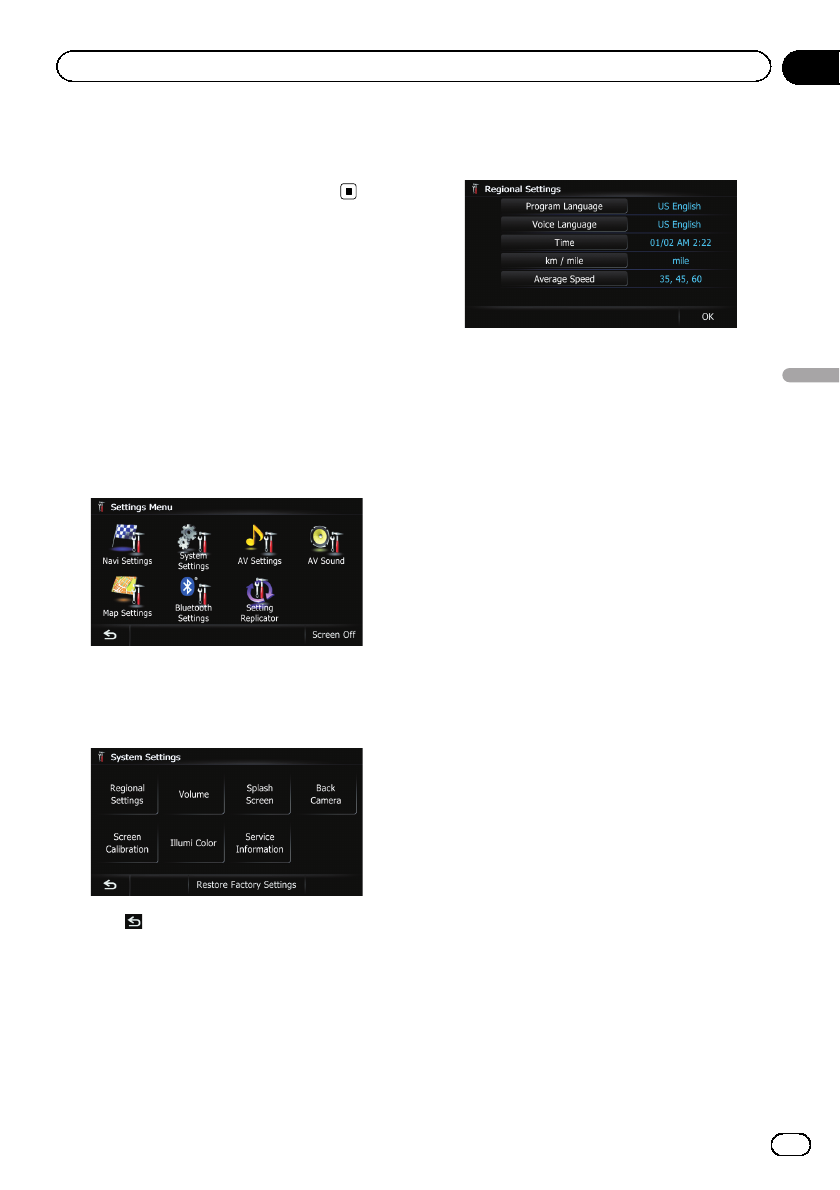
=For details, refer to Setting the “Favor-
ites”icon display on page 156.
4 To finish the setting, touch [OK].
Displaying the “System
Settings”screen
1 Press the HOME button to display the
“Top Menu”screen.
2 Touch [Settings].
The “Settings Menu”screen appears.
pThis can also be operated using the “Short-
cut Menu”screen.
3 Touch [System Settings].
The “System Settings”screen appears.
4 Touch the item that you want to
change the setting.
#Touch .
Returns the previous screen.
Customizing the regional settings
1 Display the “System Settings”screen.
=For details, refer to Displaying the “System
Settings”screen on this page.
2 Touch [Regional Settings].
The “Regional Settings”screen appears.
Selecting the language
You can set the languages used on the pro-
gram and voice guidance. Each language can
be set separately.
1 Display the “System Settings”screen.
=For details, refer to Displaying the “System
Settings”screen on this page.
2 Touch [Regional Settings].
The “Regional Settings”screen appears.
3 Touch [Program Language].
The language list is displayed.
4 Touch the desired language.
After the language is selected, the previous
screen returns.
5 Touch [Voice Language].
The “Voice Language Selection”screen ap-
pears.
6 Touch the desired language.
After the language is selected, the previous
screen returns.
7 Touch [OK] on the “Regional Settings”
screen.
A message confirming whether to restart the
navigation system appears.
8 Touch [OK].
The navigation system restarts.
#Press the MODE button or the HOME button.
Cancels the setting of the languages.
En 161
Chapter
31
Customizing preferences
Customizing preferences
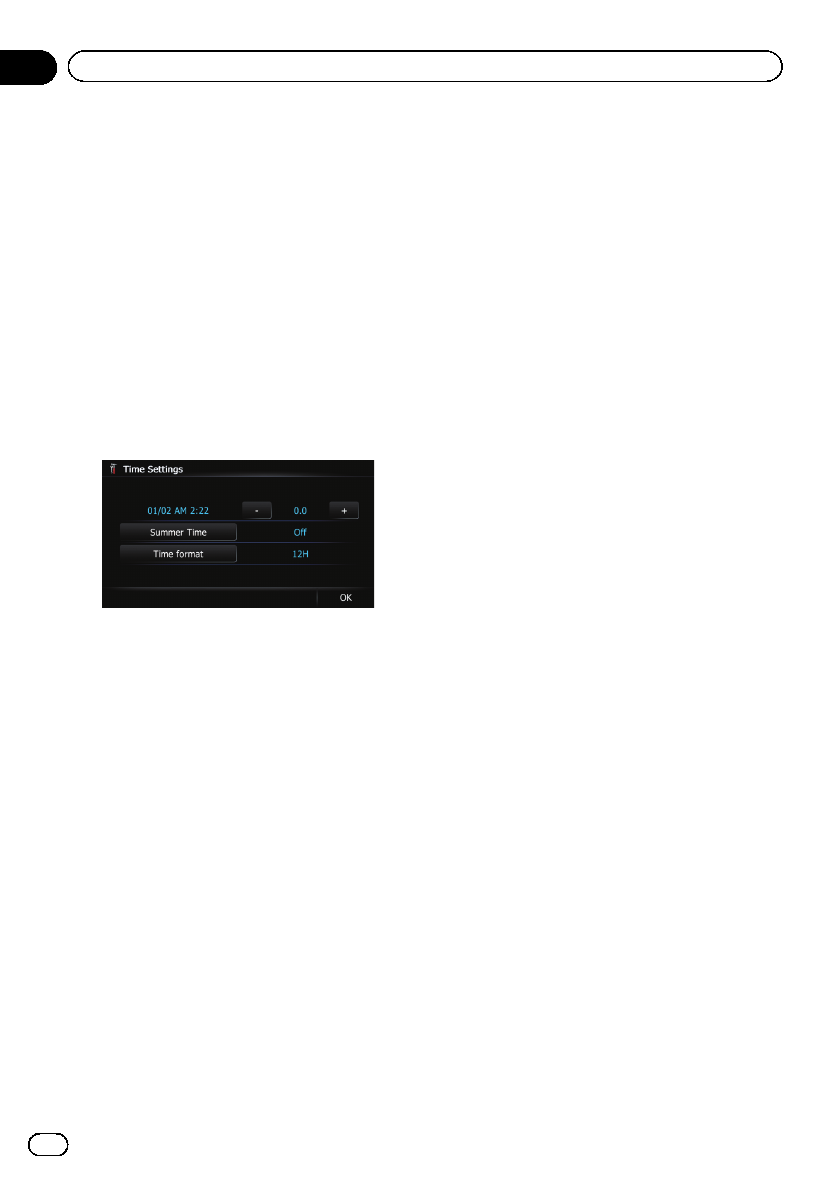
Setting the time difference
Adjusts the system’s clock. Set the time differ-
ence (+,–) from the time originally set in your
navigation system.
1 Display the “System Settings”screen.
=For details, refer to Displaying the “System
Settings”screen on the previous page.
2 Touch [Regional Settings].
The “Regional Settings”screen appears.
3 Touch [Time].
The “Time Settings”screen appears.
4 To set the time difference, touch [+] or
[–].
The time difference between the time origin-
ally set in the navigation system (Pacific Stan-
dard Time) and the current location of your
vehicle is shown. If necessary, adjust the time
difference. Touching [+]or[–] changes the
time difference display in half-hour incre-
ments.
The time difference can be set from –4to +9
hours.
5 Touch [Summer Time].
If necessary, set to summer time.
Summer time setting is off by default. Touch
[Summer Time] to change the setting if you
are in the summer time period.
6 Touch [Time format].
Each time you touch the key changes that set-
ting.
!12H (default):
Changes the display to 12-hour format with
am/pm.
!24H:
Changes the display to 24-hour format.
Changing the unit between km and miles
This setting controls the unit of distance and
speed displayed on your navigation system.
1 Display the “System Settings”screen.
=For details, refer to Displaying the “System
Settings”screen on the previous page.
2 Touch [Regional Settings].
The “Regional Settings”screen appears.
3 Touch [km / mile].
A message confirming whether to change the
setting appears.
4 Touch [Yes].
The setting is changed as follows:
!mile (default):
Shows distance in miles.
!Mile&Yard:
Shows distance in miles and yards.
!km:
Shows distance in kilometers.
#Touch [No].
Cancels the setting.
Changing the virtual speed of the vehicle
When calculating the expected time of arrival
and the travel time to the destination, set the
average speed for the freeway or ordinary
roads using [+] and [–].
1 Display the “System Settings”screen.
=For details, refer to Displaying the “System
Settings”screen on the previous page.
2 Touch [Regional Settings].
The “Regional Settings”screen appears.
3 Touch [Average Speed].
The “Average Speed Settings”screen ap-
pears.
En
162
Chapter
31 Customizing preferences
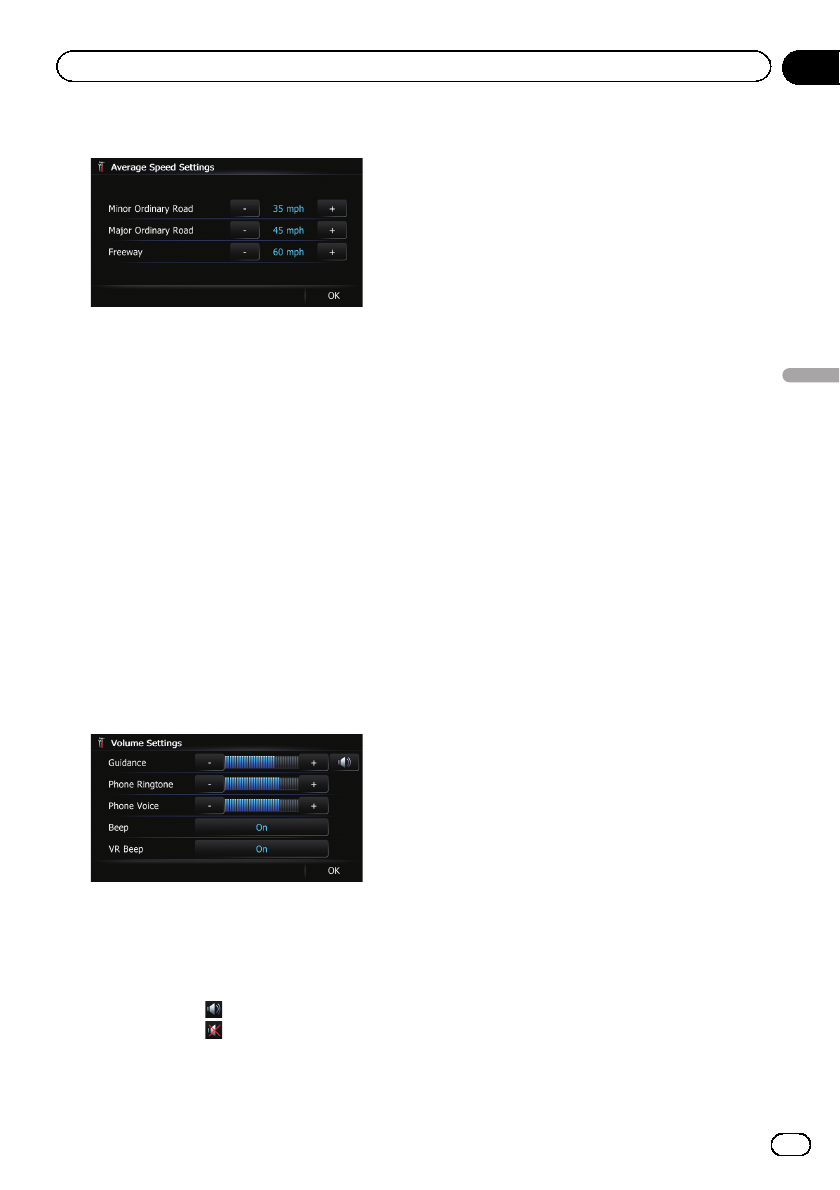
4 Touch [+] or [–] to set the speed.
pThe estimated time of arrival is not necessa-
rily estimated based on this speed value.
5 Touch [OK].
The settings are completed.
Setting the Volume for
Guidance and Phone
The sound volume for the navigation can be
set. You can separately set the volume of the
route guidance and the beep sound.
1 Display the “System Settings”screen.
=For details, refer to Displaying the “System
Settings”screen on page 161.
2 Touch [Volume].
The “Volume Settings”screen appears.
3 Touch [+] or [–] to set their volume.
On this screen, you can operate the following
items.
!Guidance
This setting controls the guidance volume
of navigation.
pWhen set to , guidance is output.
When set to , no guidance is output.
!Phone Ringtone
This setting controls the incoming ring tone
volume.
!Phone Voice
This setting controls the incoming voice vo-
lume.
p“Phone Ringtone”and “Phone Voice”ad-
justments are related to the cellular phone
featuring Bluetooth technology. No adjust-
ment is needed when the cellular phone
featuring Bluetooth technology is not con-
nected.
pVolume of the AV source is adjusted by the
VOL (+/–) button.
=For details, refer to Checking part names
and functions on page 12.
#Touch the key next to “Beep”.
Each time you touch the key changes that set-
ting.
!On (default):
A beep sounds.
!Off:
The beep sound is muted.
#Touch the key next to “VR Beep”.
Each time you touch the key changes that set-
ting.
!On (default):
Voice recognition beep is enabled.
!Off:
Voice recognition beep is disabled.
4 To finish the setting, touch [OK].
Changing the preinstalled
splash screen
You can change the splash screen to the other
images preinstalled in the navigation system.
1 Display the “System Settings”screen.
=For details, refer to Displaying the “System
Settings”screen on page 161.
2 Touch [Splash Screen].
The “Select Splash Screen”screen appears.
3 Touch the image to use as the splash
screen from the list.
The image is displayed on the screen.
En 163
Chapter
31
Customizing preferences
Customizing preferences

4 Touch [OK].
The image is set as the splash screen, and the
“System Settings”screen returns.
Changing to the splash screen
stored in the SD memory card
You can change the splash screen that ap-
pears when the navigation system starts. Copy
your chosen image to the SD memory card,
and select the image to import.
pSplash screen images should be used with-
in the following formats;
—BMP or JPEG files
—Allowable horizontal and vertical size
are 2 592 pixels x 1 944 pixels or smaller
—Allowable data size is 6 MB or smaller
pProper compatibility with allowable files is
not guaranteed.
pImported original images will be stored in
the built-in memory, but the ability to save
these images cannot be guaranteed com-
pletely. If your original image data is de-
leted, insert the SD memory card again
and re-import the original image.
pThe maximum number of images, includ-
ing the images in the built-in memory, that
can be imported and displayed on the list is
200.
1 Create a folder named “Pictures”on the
top-most directory of the SD memory card
and store the picture files in this folder.
2 Store the picture files in the “Pictures”
folder.
3 Insert an SD memory card into the SD
card slot.
=For details of the operation, refer to Insert-
ing and ejecting an SD memory card on
page 15.
4 Display the “System Settings”screen.
=For details, refer to Displaying the “System
Settings”screen on page 161.
5 Touch [Splash Screen].
The “Select Splash Screen”screen appears.
6 Touch [Select from SD].
The “Select Splash Screen”screen appears.
7 Touch the image to use as the splash
screen from the list.
The image is displayed on the screen.
8 Touch [OK].
The image is set as the splash screen, and the
“System Settings”screen returns.
pImages imported from the SD memory card
are added to the list on “Select Splash
Screen”.
Setting for rear view camera
The following two functions are available. The
rear view camera feature requires a separately
sold rear view camera (e.g. ND-BC4). (For de-
tails, consult your dealer.)
Rear view camera
The navigation system features a function that
automatically switches to the full-screen
image of the rear view camera installed on
your vehicle. When the shift lever is in the RE-
VERSE (R) position, the screen automatically
switches to full-screen rear view camera
image.
Camera for Rear view mode
“Rear View”can be displayed at all times (e.g.
when monitoring an attached trailer, etc.) as a
split screen where map information is partially
displayed. Please be aware that with this set-
ting, camera image is not resized to fit, and
that a portion of what is seen by the camera is
not viewable.
=For details, refer to Setting for rear view
camera on this page.
CAUTION
Pioneer recommends the use of a camera which
outputs mirror reversed images, otherwise the
screen image may appear reversed.
En
164
Chapter
31 Customizing preferences
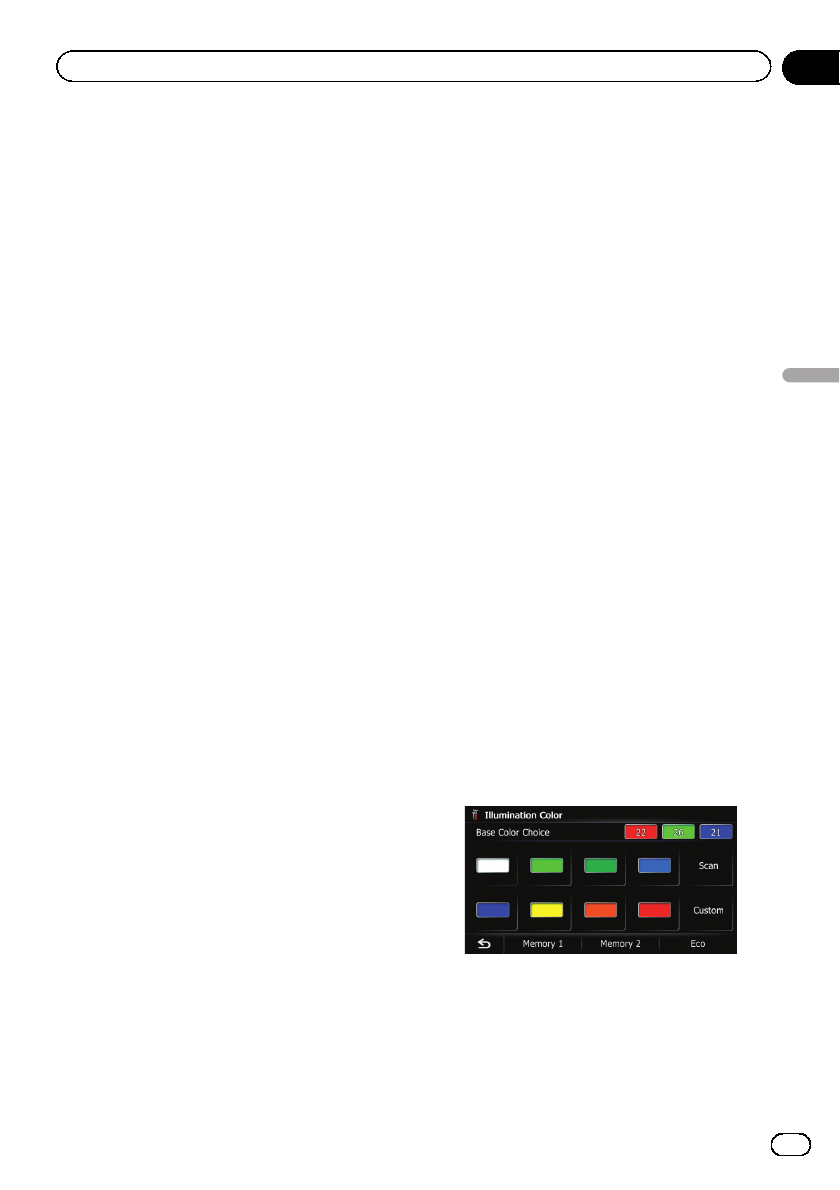
pImmediately verify whether the display
changes to a rear view camera image when
the shift lever is moved to REVERSE (R)
from another position.
pWhen the screen changes to full-screen
rear view camera image during normal
driving, switch to the opposite setting in
“Polarity”.
1 Display the “System Settings”screen.
=For details, refer to Displaying the “System
Settings”screen on page 161.
2 Touch [Back Camera].
The “Back Camera Settings”screen appears.
3 Touch [Camera] change the setting to
“On”.
pYou can only switch to “Rear View”if this
setting is “On”.
4 Touch [Battery] or [GND] next to
“Polarity”to select the appropriate polarity
setting.
!Battery: When the polarity of the con-
nected lead is positive while the shift lever
is in the REVERSE (R) position
!GND: When the polarity of the connected
lead is negative while the shift lever is in
the REVERSE (R) position
Adjusting the response
positions of the touch panel
(touch panel calibration)
If you feel that the touch panel keys on the
screen deviate from the actual positions that
respond to your touch, adjust the response po-
sitions of the touch panel screen.
pDo not use a sharp pointed tool such as a
ballpoint pen or a mechanical pen, which
could damage the screen.
1 Display the “System Settings”screen.
=For details, refer to Displaying the “System
Settings”screen on page 161.
2 Touch [Screen Calibration].
A message confirming whether to start the ca-
libration appears.
3 Gently touch the center of + mark dis-
played on the screen.
The target indicates the order.
After you touch all marks, the adjusted posi-
tion data is saved.
pDo not turn off the engine while saving the
adjusted position data.
#Press the MODE button.
Returns to the previous adjustment position.
#Press and hold the MODE button.
Cancels the adjustment.
Setting the illumination color
The illumination color can be selected from 10
different colors. Furthermore, the illumination
color can be switched between these 10 colors
in order.
Selecting the color from the preset
colors
1 Display the “System Settings”screen.
=For details, refer to Displaying the “System
Settings”screen on page 161.
2 Touch [Illumi Color].
The “Illumination Color”screen appears.
3 Touch the color you want.
Available options:
!Colored keys: Selects the desired preset
color
!Memory 1/Memory 2 : Colors registered in
the memory
En 165
Chapter
31
Customizing preferences
Customizing preferences
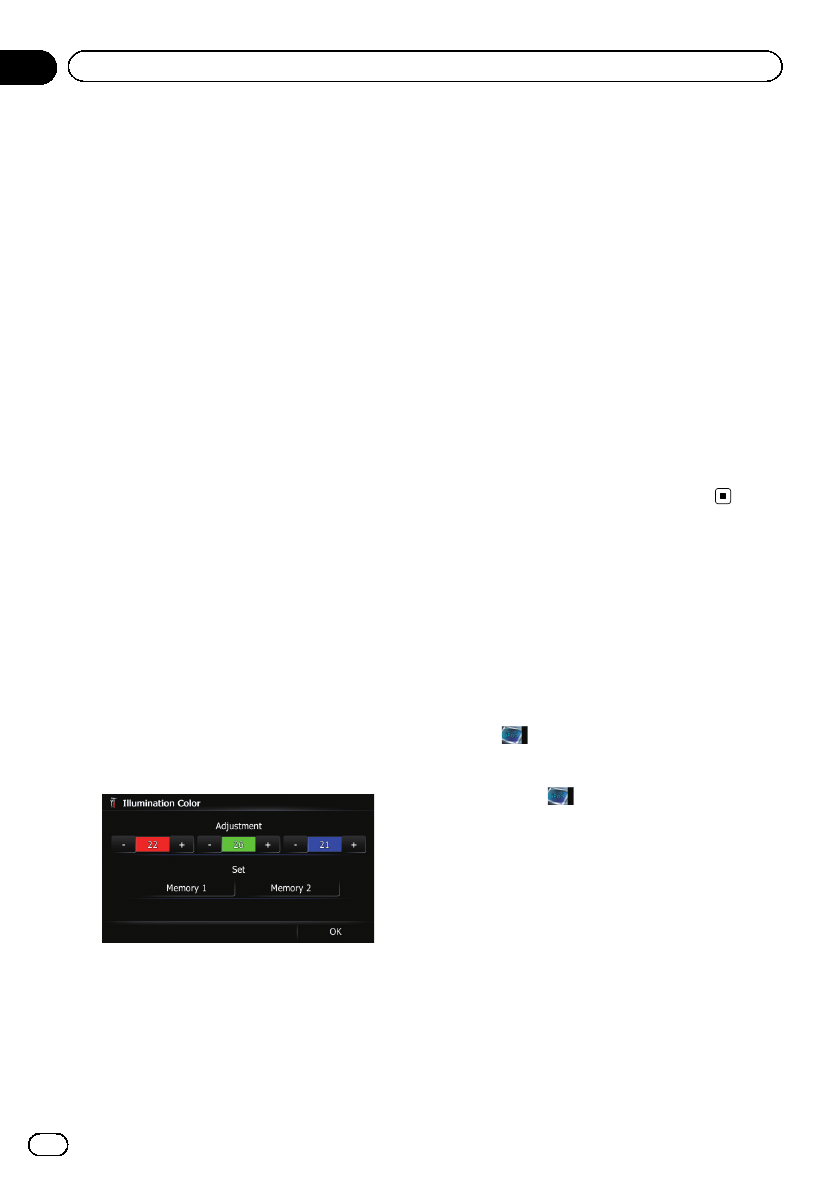
=For details, refer to Creating a user-de-
fined color and storing it to memory on
this page.
!Scan: Shifts between the eight default col-
ors in sequence gradually.
!Eco: The colors change in the order of
white, red, amber, yellow, green, and blue
as the number of points in the “Eco Score”
increases.
pThe illumination lights in white when
“Eco Score”is set to “Off”or when no
route is set.
Creating a user-defined color and
storing it to memory
You can create a user-defined color and set it
as the illumination color.
1 Display the “System Settings”screen.
=For details, refer to Displaying the “System
Settings”screen on page 161.
2 Touch [Illumi Color].
The “Illumination Color”screen appears.
3 Touch [Custom].
The “Illumination Color”screen appears.
pIf [Scan] is set, [Custom] cannot be se-
lected.
4 Touch [+] or [–] to adjust the values for
Red, Green and Blue to create a favorite
color.
Watch the illumination of hardware keys while
adjusting the color.
Each time you touch [+]or[–] increases or de-
creases the value of the selected item. +31 to
+00 is displayed as the value is increased or
decreased.
pAn entry cannot be stored with all of the va-
lues set to “+00”.
5 Touch [Memory 1] or [Memory 2] to
store the illumination color.
6 Touch [OK] to return to the previous
screen.
Checking the version information
1 Display the “System Settings”screen.
=For details, refer to Displaying the “System
Settings”screen on page 161.
2 Touch [Service Information].
The “Service Information Screen”screen ap-
pears.
3 Check the version information.
Selecting the video for
“Rear display”
pThis function is available for AVIC-Z120BT
only.
You can choose either to show the same
image as the front screen or to show the se-
lected source on the “Rear display”.
%Tap on the left edge of the screen.
pThe appearance of this key changes accord-
ing to the current setting.
Each touch of changes the settings as fol-
lows:
!Mirror AV: The video on the front screen of
the navigation unit is output to the “Rear
display”
!DISC: The video and sound of the DVDs are
output to the “Rear display”
!iPod: The video and sound of the iPod or
Pandora are output to the “Rear display”
!AV1: The video and sound of AV1 are out-
put to the “Rear display”
!AV2: The video and sound of AV2 are out-
put to the “Rear display”
pWhen “Mirror AV”is selected, the following
restrictions are applied to “Rear display”.
En
166
Chapter
31 Customizing preferences
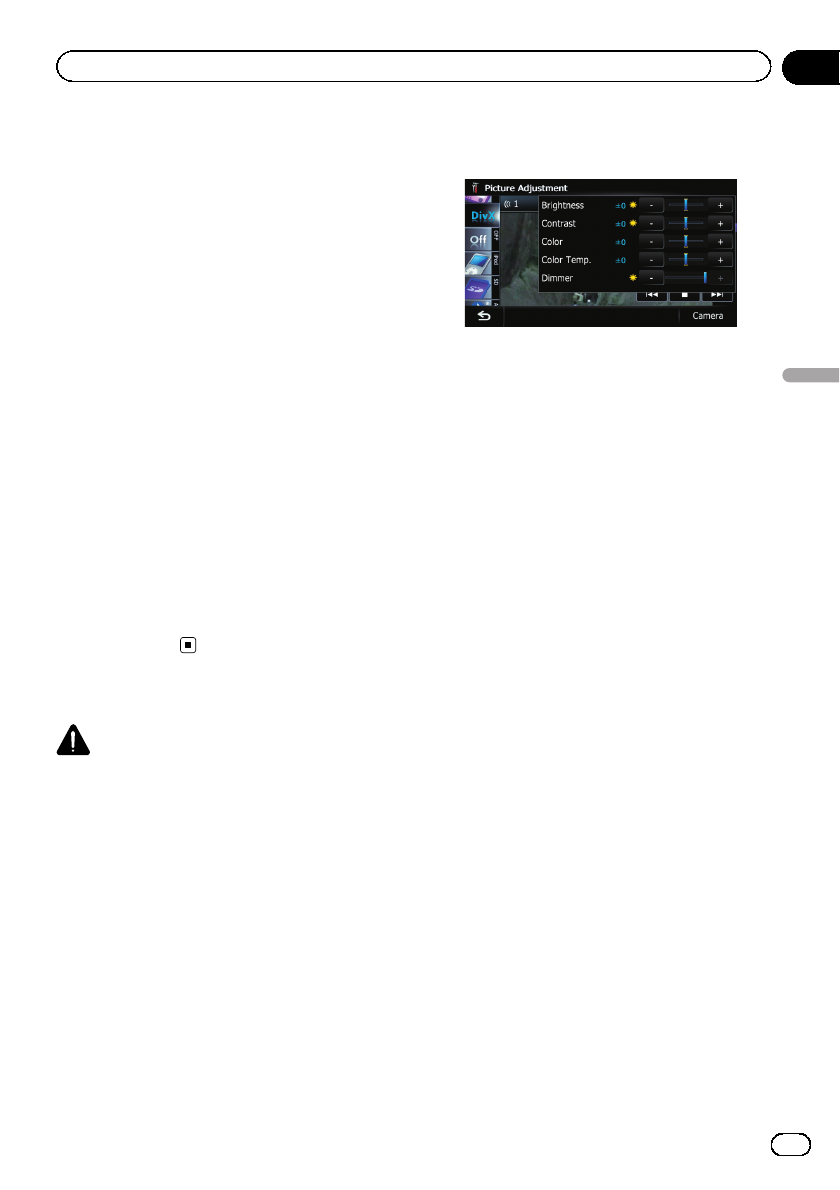
—When selecting “Rear View”in the map
display, nothing is displayed.
—All sounds cannot be output for “Rear
display”.
—When playing back video files on the ex-
ternal storage device (USB, SD), the
video image is not output.
pWhen “DISC”is selected, the following re-
striction is applied to “Rear display”.
—When a CD or MP3/WMA/AAC disc is
set in the built-in DVD drive, only the
sound is output.
pWhen “iPod”is selected, the following re-
striction is applied to “Rear display”.
—The video image and sound are output
only when the appropriate setting on
“AV1 Input”is “iPod”.
pWhen “AV”is selected, the following re-
strictions are applied to “Rear display”.
—The video image and sound are output
only when AV1/AV2 has both video and
sound.
—The video image and sound are output
only when the appropriate setting on
“AV1 Input”or “AV2 Input”are
“Video”.
Adjusting the picture
CAUTION
For safety reasons, you cannot use some of these
navigation functions while your vehicle is in mo-
tion. To enable these functions, you must stop in
a safe place and apply the parking brake. Refer to
Important Information for the user (a separate
manual).
You can adjust the picture for each source and
rear view camera.
1 Press and hold the MODE button.
The “Picture Adjustment”screen appears.
2 Touch [+] or [–] to adjust the desired
item.
!Brightness: Adjusts the black intensity.
!Contrast: Adjusts the contrast.
!Color: Adjusts the color saturation.
!Color Temp.: Adjusts the tone of color (red
is emphasized or green is emphasized).
!Dimmer: Adjusts the brightness of display.
pTouching [Camera] switches to the picture
adjustment screen for the rear view cam-
era.
pTouching [Source] while adjusting the rear
view camera image returns you to the pre-
vious screen.
pThe adjustments of Brightness and
Contrast are stored separately when your
vehicle’s headlights are off (daytime) and
when your vehicle’s headlights are on
(nighttime). These are switched automati-
cally depending on whether the vehicle’s
headlights are on or off.
pThe adjustments of Dimmer is stored sepa-
rately when your vehicle’s headlights are off
(daytime) and when your vehicle’s head-
lights are on (nighttime). Dimmer is
switched automatically only when the value
of nighttime is lower than the value of day-
time.
pYou cannot adjust Color for the source
without a video and navigation map display.
pThe setting contents can be memorized se-
parately for the following screen and the
video image.
—AM/FM/CD/ROM/iPod(Music)/Pan-
dora/SD(audio)/USB(audio)/Bluetooth
Audio/XM/SIRIUS/Digital Radio screen
—AV1 and iPod(Video)
—DVD-V and DivX
—SD(Video) and USB(Video)
En 167
Chapter
31
Customizing preferences
Customizing preferences
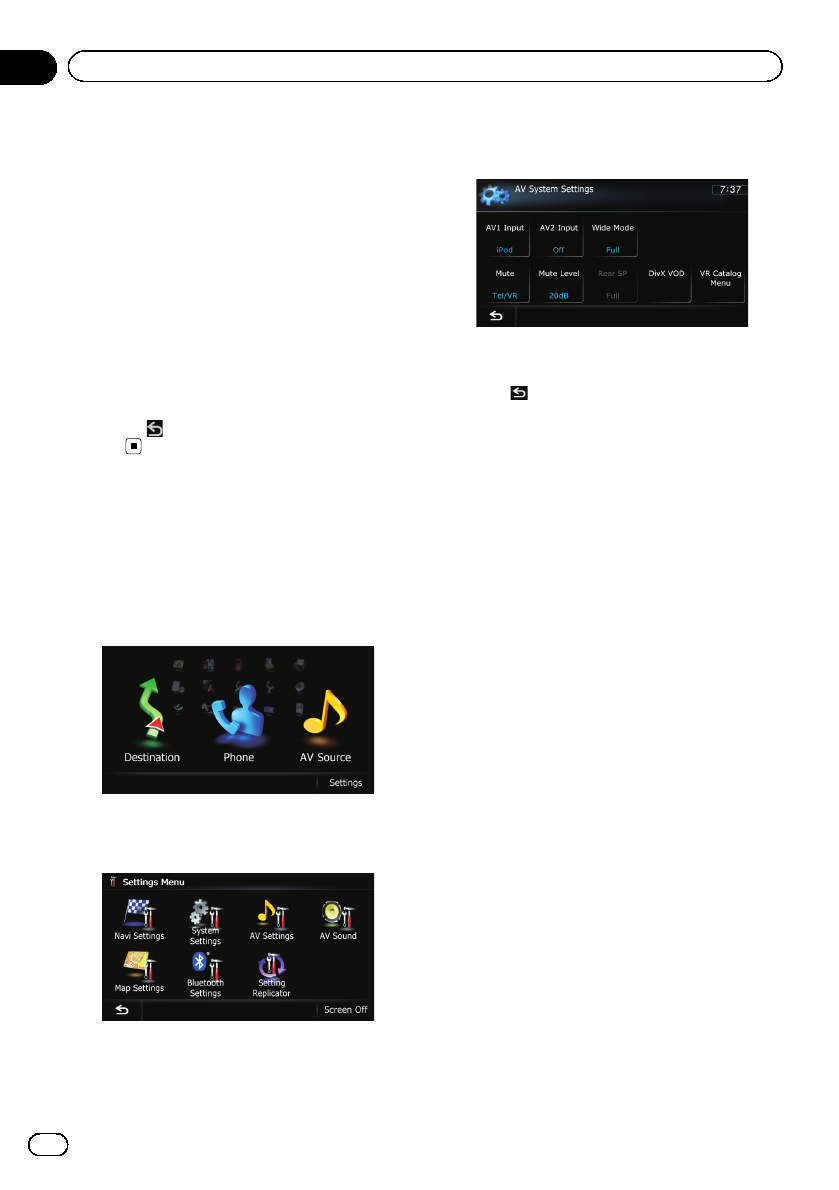
—AV2(Video) and EXT1(Video), EXT2
(Video)
—Rear view camera image
—Map screen
pThe picture adjustment may not be avail-
able with some rear view cameras.
pBecause of the LCD screen characteristics,
you may not be able to adjust the screen at
low temperatures.
3 Touch [+] or [–] to adjust the desired
item.
Each touch of [+]or[–] increases or decreases
the level of the desired item.
4 Touch to return to the previous
screen.
Displaying the “AV System
Settings”screen
1 Press the HOME button to display the
“Top Menu”screen.
2 Touch [Settings].
The “Settings Menu”screen appears.
3 Touch [AV Settings].
The “AV System Settings”menu appears.
4 Touch the item that you want to
change the setting.
pYou can only adjust “Wide Mode”when se-
lecting an AV source with video.
#Touch .
Returns the previous screen.
Setting video input 1 (AV1)
You can switch this setting according to the
connected component.
pThis setting applies to mini-jack input.
1 Display the “AV System Settings”
screen.
=For details, refer to Displaying the “AV Sys-
tem Settings”screen on this page.
2 Touch [AV1 Input].
Each touch of [AV1 Input] changes the set-
ting as follows:
!iPod: iPod connected with the USB Inter-
face cable for iPod (CD-IU50V)
!Video: External video component
!Off: No video component is connected.
pUse AV1 Input when connecting CD-IU50V
(sold separately) through the external video
component.
Setting video input 2 (AV2)
You can switch this setting according to the
connected component.
pThis setting applies to RCA inputs
(AUDIO INPUT and VIDEO INPUT) on the
back of the system.
En
168
Chapter
31 Customizing preferences

1 Display the “AV System Settings”
screen.
=For details, refer to Displaying the “AV Sys-
tem Settings”screen on the previous page.
2 Touch [AV2 Input].
Each touch of [AV2 Input] changes the set-
ting as follows:
!Off: No video component is connected.
!EXT: Pioneer external unit connected with
the RCA video cable
!Video: External video component
Changing the wide screen mode
1 Display the “AV System Settings”
screen.
=For details, refer to Displaying the “AV Sys-
tem Settings”screen on the previous page.
2 Touch [Wide Mode].
Each touch of [Wide Mode] changes the set-
ting as follows:
!Full (full)
A 4:3 picture is enlarged in the horizontal
direction only, enabling you to enjoy a 4:3
TV picture (normal picture) without any
omissions.
!Cinema (cinema)
A picture is enlarged by the same propor-
tion as Full or Zoom in the horizontal direc-
tion and by an intermediate proportion
between Full and Zoom in the vertical di-
rection; ideal for a cinema-sized picture
(wide screen picture) where captions lie
outside the frame.
!Zoom (zoom)
A 4:3 picture is enlarged in the same pro-
portion both vertically and horizontally;
ideal for a cinema-sized picture (wide
screen picture).
!Normal (normal)
A 4:3 picture is displayed normally, giving
you no sense of disparity since its propor-
tions are the same as that of the normal
picture.
pDifferent settings can be stored for each
video source.
pThe same setting is automatically applied
for the following grouping.
!DVD-V and DivX
!AV1 and AV2
!EXT1 and EXT2
pWhen video is viewed in a wide screen
mode that does not match its original as-
pect ratio, it may look strange.
pRemember that use of this system for com-
mercial or public viewing purposes may
constitute an infringement on the author’s
rights protected by the Copyright Law.
pThe navigation map and the rear view cam-
era picture is always viewed at Full.
Setting the rear output
The navigation system’s rear output can be
used for a full-range speaker or subwoofer
connection. If you switch Rear SP to Sub. W,
you can connect a rear speaker lead directly to
a subwoofer without using an auxiliary amp.
Initially, the navigation system is set for a rear
full-range speaker connection (Full).
pBoth rear speaker leads output and RCA
rear output are switched simultaneously in
this setting. (When you use the product
without RCA rear output, this setting only
applies to the rear speaker leads.)
p“Rear SP”can be set only when the source
is selected to “Off”.
1 Display the “AV System Settings”
screen.
=For details, refer to Displaying the “AV Sys-
tem Settings”screen on the previous page.
2 Touch [Rear SP].
Each touch of [Rear SP] changes the settings
as follows:
!Full
When no subwoofer is connected to the
rear output, select “Full”.
!Sub. W
When a subwoofer is connected to the rear
output, select “Sub. W”.
En 169
Chapter
31
Customizing preferences
Customizing preferences

Switching the muting/
attenuation timing
You can mute the AV source volume or attenu-
ate the output signal. This setting is invalid for
the mute signal that has been received from
the MUTE lead connected to the navigation
unit. (Even if this setting is “Off”, the naviga-
tion system will mute or attenuate the audio
source volume when the signal is output via
MUTE lead.)
1 Display the “AV System Settings”
screen.
=For details, refer to Displaying the “AV Sys-
tem Settings”screen on page 168.
2 Touch [Mute].
Each touch of [Mute] changes the settings as
follows:
!Guide/Tel/VR: The volume is muted or atte-
nuated according to the following condi-
tions.
—When the navigation outputs the gui-
dance voice.
—When you use a cellular phone via Blue-
tooth technology (dialing, talking, in-
coming call).
—When the voice recognition mode is ac-
tivated.
!Tel/VR: The volume is muted or attenuated
according to the following conditions.
—When you use a cellular phone via Blue-
tooth technology (dialing, talking, in-
coming call).
—When the voice recognition mode is ac-
tivated.
!Off: The volume does not change.
pAV source volume returns to normal when
the corresponding action is ended.
Switching the muting/
attenuation level
You can select the muting/attenuation level of
“Mute”. This setting is also effective for a
mute signal that has been received from the
MUTE lead connected to the navigation unit.
pThis menu is not available when AV source
is “Off”.
1 Display the “AV System Settings”
screen.
=For details, refer to Displaying the “AV Sys-
tem Settings”screen on page 168.
2 Touch [Mute Level].
Each touch of [Mute Level] changes the set-
tings as follows:
!20dB: The volume becomes 1/10.
!10dB: The volume becomes 1/3.
!All: The volume becomes 0.
pWhen you select “All”, no audio adjust-
ments are possible during the sound is
turned off.
pWhen you select “20dB”or “10dB”,no
audio adjustments are possible during the
sound is attenuated.
pAV source volume returns to normal when
the corresponding action is ended.
pEven when a mute signal has been received
from MUTE lead connected to the naviga-
tion unit, navigation voice guidance cannot
be attenuated or muted.
Acquiring/Cataloging iPod
music information
If you always set the language other than “Eng-
lish”on “Voice Language”, this setting is un-
necessary.
Unless “VR Catalog Mode”is turned off, this
navigation system tries to acquire the informa-
tion needed to operate iPod with voice com-
mands. It may take a short period of time to
transfer the information. Change the setting
according to your usage.
The navigation system starts acquiring/catalo-
ging music information (1) when the iPod is
connected or when the system boots up while
the iPod is connected and (2) when iPod is the
selected and displayed AV Source, unless “VR
Catalog Mode”is turned off.
En
170
Chapter
31 Customizing preferences

pThis function is available when “Change
Control Mode”is set to “Navi”.
pIf you do not use iPod, this setting is un-
necessary.
pDuring transfer, the following iPod opera-
tions are not available.
—Setting the shuffle play for music
—Displaying the top category menu
—Switching the operation screen
pOnce the cataloging is completed, you can
deactivate “VR Catalog Menu”until you
update the content/data on iPod. If you up-
date the iPod data, activate “VR Catalog
Menu”again to transfer the music infor-
mation and synchronize the music informa-
tion for voice commands with the data on
iPod.
pAfter you select “Off”in “VR Catalog
Mode”, the system doesn’t catalog the
data on the iPod. In such case, the pre-
viously cataloged data are available as
voice commands.
pOnce you start the cataloging process, only
a few basic voice commands can be used
for iPod until the process has completely
finished.
pIf unreadable characters are included in
the data on your iPod, names or types may
not be available as voice commands.
Important Notice regarding Voice
Control for iPods
Voice Control for iPods may be limited if cata-
loging of iPod content is not completed. Cata-
loging of iPod content only occurs when the
system is in “AV Source”mode and the “iPod”
is the selected and displayed “AV Source”
screen. Cataloging of iPod content will not
occur if the system is off, if any other “AV
Source”is selected (aside from iPod), or if the
system is in any other mode (aside from “AV
Source”mode) such as “Destination Menu”,
“Settings Menu”,“Phone Menu”or the map
screen. If you wish to use Voice Control for all
iPod content, it is recommended that you first
connect your iPod, select “iPod”as the AV
source, and keep the iPod screen displayed
until cataloging is completed —cataloging of
iPod content should only take a few minutes,
and will depend on the size of the content
stored on your iPod. A message will be dis-
played when cataloging is completed.
1 Display the “AV System Settings”
screen.
=For details, refer to Displaying the “AV Sys-
tem Settings”screen on page 168.
2 Touch [VR Catalog Menu].
3 Touch [On] or [Off] to activate or deacti-
vate “VR Catalog Mode”.
#Touch [Pause].
The cataloging of iPod stops.
If you want to restart the cataloging of iPod,
touch [Restart].
Displaying your DivX VOD
registration code
In order to play DivX VOD (video on demand)
content on this navigation system, you first
need to register the unit with your DivX VOD
content provider. You do this by generating a
DivX VOD registration code, which you submit
to your provider.
pThis feature is available when the selected
source is CD,ROM,DivX,orDVD-V.
1 Display the “AV System Settings”
screen.
=For details, refer to Displaying the “AV Sys-
tem Settings”screen on page 168.
2 Touch [DivX VOD].
Your 8-digit registration code is displayed.
pMake a note of the code as you will need it
when you register with a DivX VOD
provider.
Displaying the “AV Sound
Settings”screen
1 Press the HOME button to display the
“Top Menu”screen.
En 171
Chapter
31
Customizing preferences
Customizing preferences
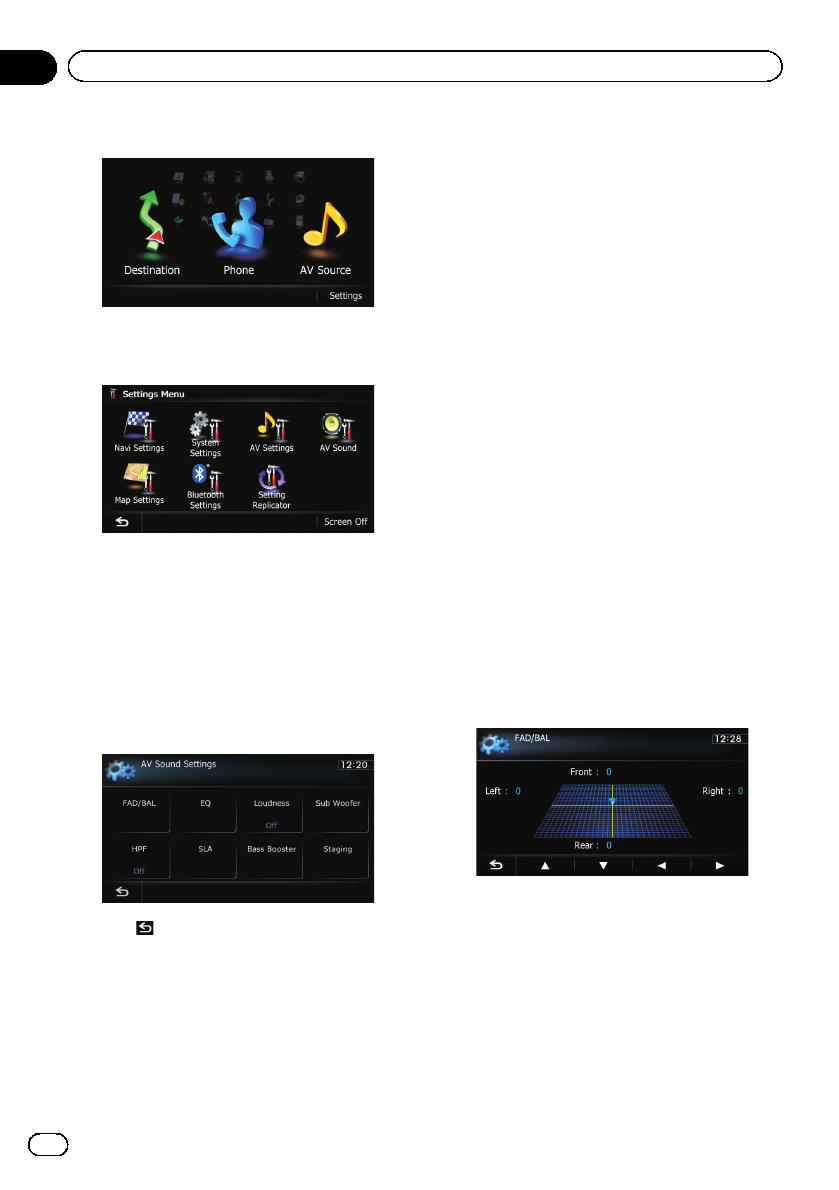
2 Touch [Settings].
The “Settings Menu”screen appears.
3 Touch [AV Sound].
The “AV Sound Settings”screen appears.
pYou cannot make adjustments in the follow-
ing situations:
—AV source is “Off”.
—During muting/attenuation
pYou cannot select “SLA”when the FM tuner
is selected as the AV source.
4 Touch the item that you want to
change the setting.
#Touch .
Returns the previous screen.
Using balance adjustment
You can select a fader/balance setting that
provides an ideal listening environment in all
occupied seats.
1 Display the “AV Sound Settings”
screen.
=For details, refer to Displaying the “AV
Sound Settings”screen on the previous
page.
2 Touch [FAD/BAL].
When “Sub. W”is selected in “Rear SP”,
“Balance”will be displayed instead of
“FAD/BAL”and front/rear speaker balance
cannot be adjusted.
=For details, refer to Setting the rear output
on page 169.
3 Touch [a]or[b] to adjust front/rear
speaker balance.
Each time you touch [a]or[b], the front/rear
speaker balance moves towards the front or
the rear.
“Front:15”to “Rear:15”is displayed as the
front/rear speaker balance moves from front to
rear.
Setting “Front:”and “Rear:”to “0”is correct
when using a two speaker system.
4 Touch [c]or[d] to adjust left/right
speaker balance.
Each time you touch [c]or[d], the left/right
speaker balance moves towards the left or the
right.
“Left:15”to “Right:15”is displayed as the left/
right speaker balance moves from left to right.
Using the equalizer
The equalizer lets you adjust equalization to
match vehicle interior acoustic characteristics
as desired.
En
172
Chapter
31 Customizing preferences
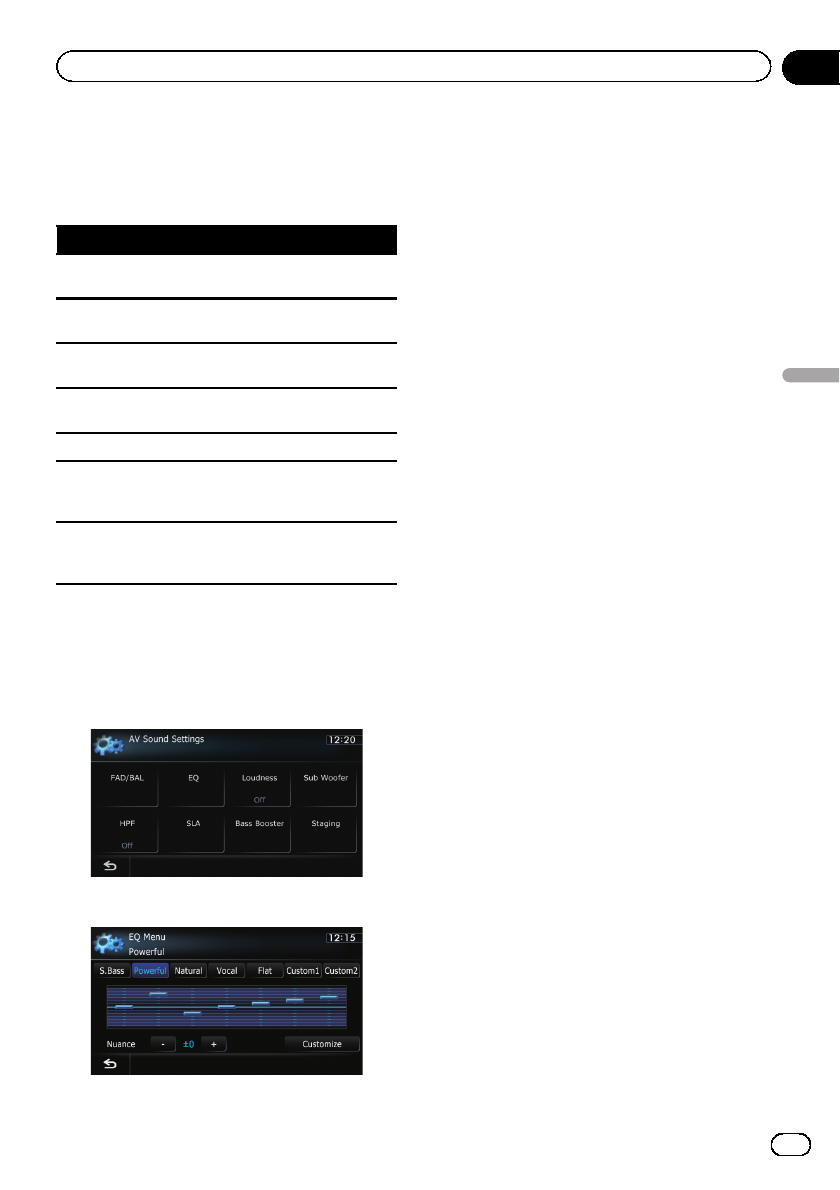
Recalling equalizer curves
There are seven stored equalizer curves that
you can easily recall at any time. Here is a list
of the equalizer curves:
Equalizer curve
SuperBass is a curve in which only low-pitched
sound is boosted.
Powerful is a curve in which low-pitched and high-
pitched sounds are boosted.
Natural is a curve in which low-pitched and high-
pitched sounds are slightly boosted.
Vocal is a curve in which the midrange, which is the
human vocal range, is boosted.
Flat is a flat curve in which nothing is boosted.
Custom1 is an adjusted equalizer curve that you cre-
ate. A separate custom curve can be created for each
source.
Custom2 is an adjusted equalizer curve that you cre-
ate. If you select this curve, the effect is reflected all
AV source.
1 Display the “AV Sound Settings”
screen.
=For details, refer to Displaying the “AV
Sound Settings”screen on page 171.
2 Touch [EQ].
3 Touch the equalizer you want.
Adjusting the preset equalizer curve
effect
You can adjust the effect of the preset equali-
zer curves.
The following equalizer curves can be ad-
justed:
!SuperBass
!Powerful
!Natural
!Vocal
1 Display the “AV Sound Settings”
screen.
=For details, refer to Displaying the “AV
Sound Settings”screen on page 171.
2 Touch [EQ].
3 Touch the equalizer you want.
4 Touch [+] or [–] next to “Nuance”.
pThe level can be adjusted in the range of –6
to +6.
pIf “Natural”is selected, the level can be ad-
justed in the range of –4to+6.
Adjusting the equalizer curves
You can adjust the currently selected equalizer
curve setting as desired. Adjustments can be
made with a 7-band graphic equalizer.
The difference between “Custom1”and
“Custom2”
!A separate Custom1 curve can be created
for each source. If you make adjustments
when a curve SuperBass,Powerful,
Natural,Vocal,Flat,orCustom1 is se-
lected, the equalizer curve settings will be
memorized in Custom1.
!ACustom2 curve can be created common
to all sources. If you make adjustments
when Custom2 curve is selected, the Cus-
tom2 curve will be updated.
!The adjusted Custom1 curve is memorized
for each of the source selected, but one
curve is shared for the following sources.
—CD,ROM,DVD-V, and DivX
—AM and FM
—EXT1 and EXT2
En 173
Chapter
31
Customizing preferences
Customizing preferences
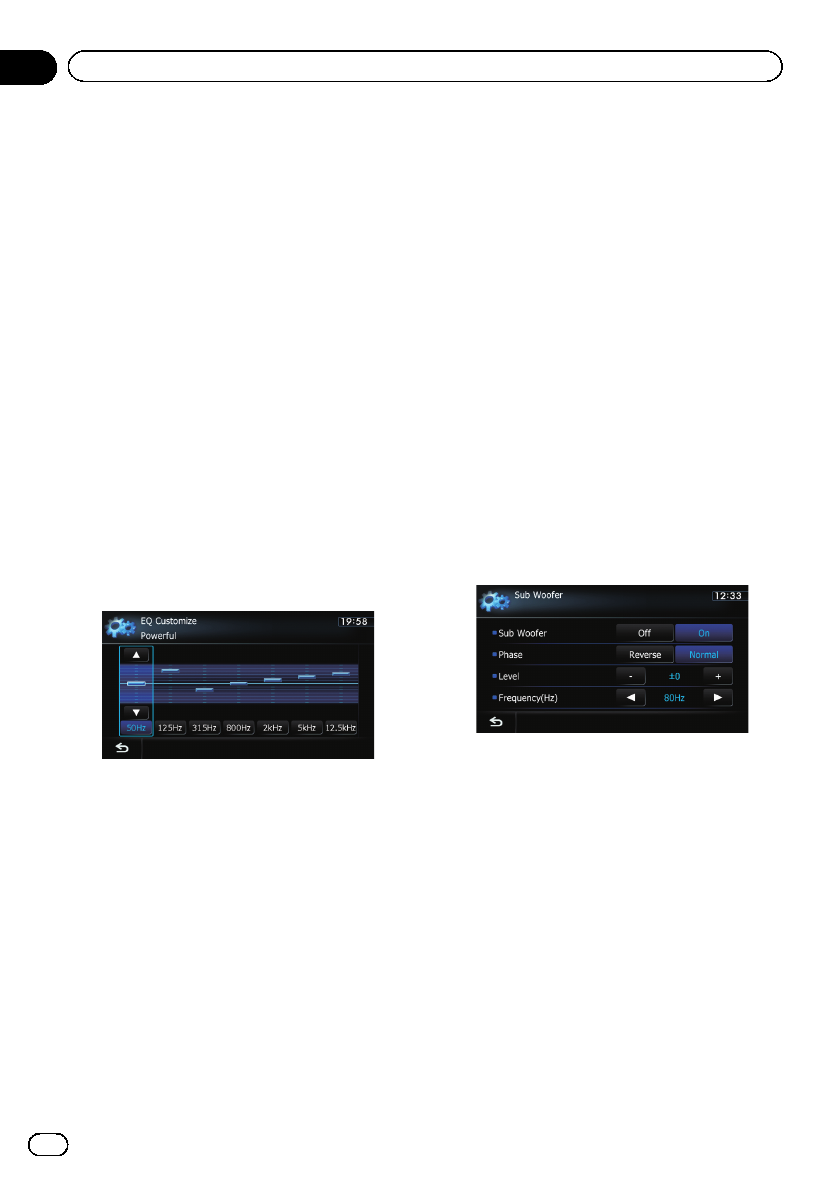
—AV1 and AV2
—SD and USB
!The different source volume level can be
set between iPod and USB.
!When “Flat”is selected, no supplement or
correction is made to the sound. This is
useful to check the effect of the equalizer
curves by switching alternatively between
“Flat”and a set equalizer curve.
1 Display the “AV Sound Settings”
screen.
=For details, refer to Displaying the “AV
Sound Settings”screen on page 171.
2 Touch [EQ].
3 Touch one of the keys to select a curve
that you want to use as the basis of custo-
mizing.
4 Touch [Customize].
5 Touch the frequency that you want to
adjust the level.
6 Touch [a]or[b] to adjust the level of
the equalizer band.
Each time you touch [a]or[b], the level of
the equalizer band increases or decreases.
Adjusting loudness
Loudness compensates for deficiencies in the
low- and high-sound ranges at low volume.
1 Display the “AV Sound Settings”
screen.
=For details, refer to Displaying the “AV
Sound Settings”screen on page 171.
2 Touch [Loudness].
Each time you touch [Loudness], the level is
selected in the following order:
Off —Low —Mid —High
Using subwoofer output
The navigation system is equipped with a sub-
woofer output mechanism, which can be
turned on or off.
pThis function is not available when “Sub
Woofer”is “Off”.
1 Display the “AV Sound Settings”
screen.
=For details, refer to Displaying the “AV
Sound Settings”screen on page 171.
2 Touch [Sub Woofer].
3 Touch [On] to turn subwoofer output
on.
To turn subwoofer output off, touch [Off].
4 Touch [Reverse] or [Normal] to select
the phase of subwoofer output.
5 Touch [+] or [–] next to “Level”to adjust
the output level.
“+6”to “–24”is displayed as the level is in-
creased or decreased.
6 Touch [c]or[d] next to
“Frequency(Hz)”to select cut-off fre-
quency.
Each time you touch [c]or[d], cut-off fre-
quencies are selected in the following order:
50Hz —63Hz —80Hz —100Hz —125Hz
Only frequencies lower than those in the se-
lected range are output from the subwoofer.
En
174
Chapter
31 Customizing preferences
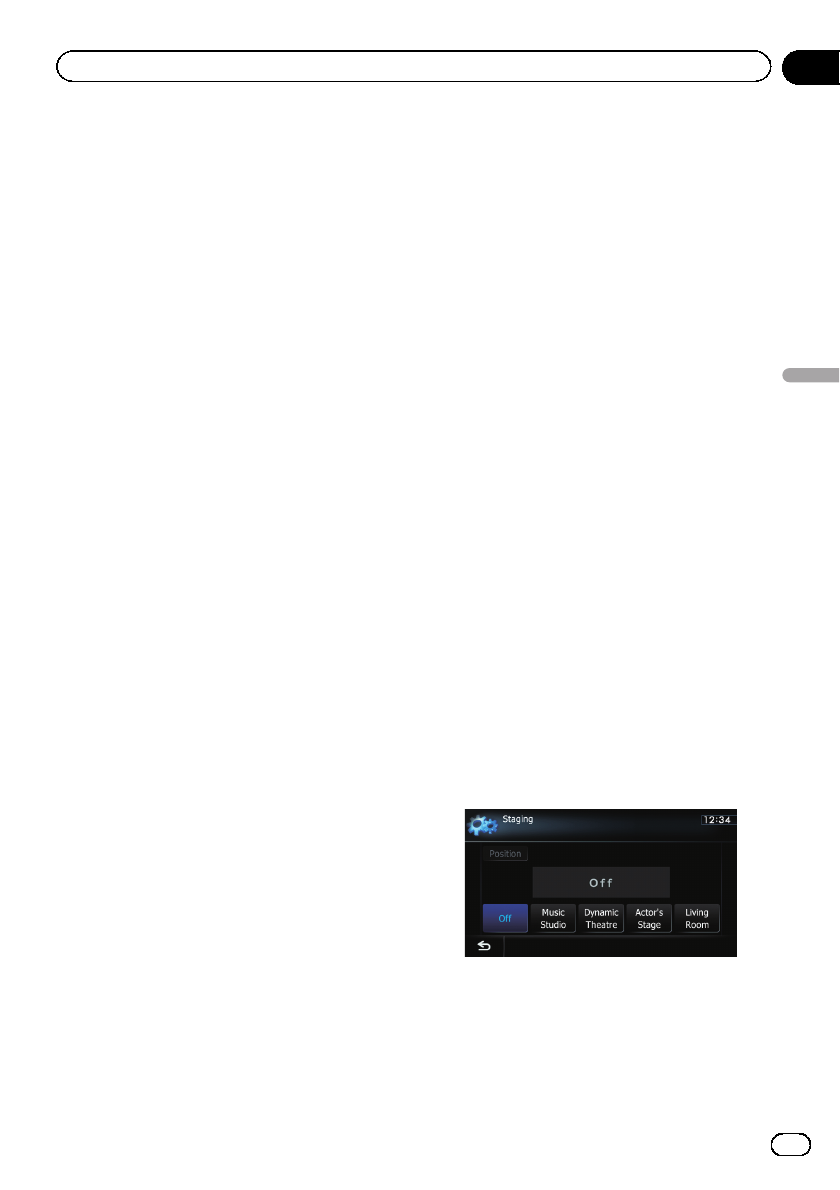
Using the high pass filter
When you do not want low sounds from the
subwoofer output frequency range to play
from the front or rear speakers, activate HPF
(high pass filter). Only frequencies higher than
those in the selected range are output from
the front or rear speakers.
1 Display the “AV Sound Settings”
screen.
=For details, refer to Displaying the “AV
Sound Settings”screen on page 171.
2 Touch [HPF].
Each time you touch [HPF] selects cut-off fre-
quencies in the following order:
Off —50Hz —63Hz —80Hz —100Hz —
125Hz
Adjusting source levels
SLA (source level adjustment) lets you adjust
the volume level of each source to prevent ra-
dical changes in volume when switching be-
tween sources.
pSettings are based on the FM tuner volume
level, which remains unchanged.
1 Compare the FM tuner volume level
with the level of the source you wish to ad-
just.
2 Display the “AV Sound Settings”
screen.
=For details, refer to Displaying the “AV
Sound Settings”screen on page 171.
3 Touch [SLA].
4 Touch [+] or [–] to adjust the source vo-
lume.
“+8dB”to “–8dB”is displayed as the source
volume is increased or decreased.
The following AV sources are set to the same
source level adjustment volume automatically.
!CD,ROM,DivX
!SD and USB
!AV1 and AV2
!EXT1 and EXT2
pThe different source volume level can be set
between iPod and USB.
Enhancing bass (Bass Booster)
You can enhance bass sounds that are often
muted by driving noise.
1 Display the “AV Sound Settings”
screen.
=For details, refer to Displaying the “AV
Sound Settings”screen on page 171.
2 Touch [Bass Booster].
3 Touch [+] or [–] to adjust the range from
0to6.
Setting the simulated sound stage
You can select the desired effect from various
simulated sound stages, such as Music Studio
or Dynamic Theater. You can also adjust a lis-
tener positioning effect.
Setting a stage that fits your image
1 Display the “AV Sound Settings”
screen.
=For details, refer to Displaying the “AV
Sound Settings”screen on page 171.
2 Touch [Staging].
3 Touch desired stage setting.
p“Living Room”setting that emphasizes
mid-range sound hardly has any effect near
the maximum volume level.
pWhen you set staging to an option other
than “Off”, the high pass filter (HPF) setting
turns “Off”.
En 175
Chapter
31
Customizing preferences
Customizing preferences
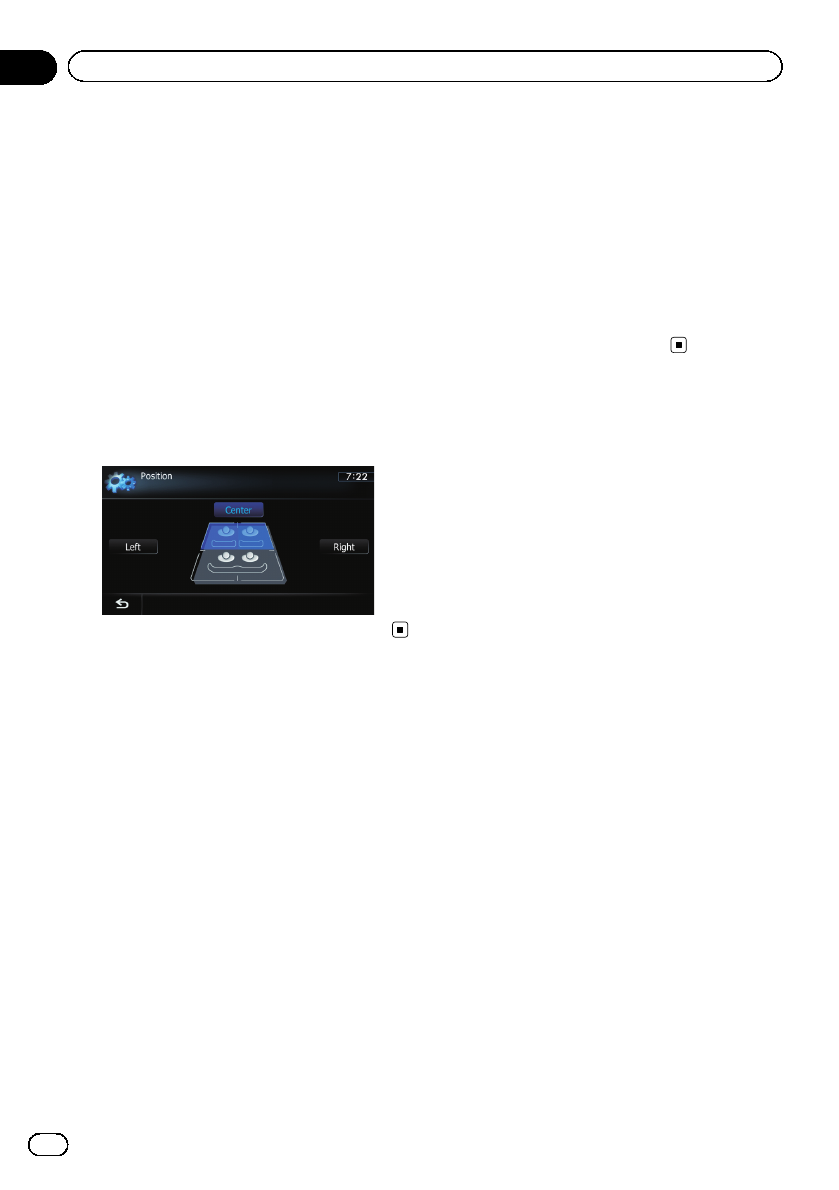
=For details, refer to Using the high pass filter
on the previous page.
Adjusting a position effect
You can select a listener position that you
want to make as the center of sound effects.
1 Display the “AV Sound Settings”
screen.
=For details, refer to Displaying the “AV
Sound Settings”screen on page 171.
2 Touch [Staging].
3 Touch [Position].
4 Touch desired position.
Replicating the settings
You can import settings you have made on the
utility program AVIC FEEDS which is available
separately to the navigation system.
1 Use AVIC FEEDS to replicate the set-
tings and store them on an SD memory
card.
2 Insert an SD memory card into the SD
card slot.
=For details of the operation, refer to Insert-
ing and ejecting an SD memory card on
page 15.
3 Press the HOME button to display the
“Top Menu”screen.
4 Touch [Settings].
The “Settings Menu”screen appears.
5 Touch [Setting Replicator].
A message confirming whether to update the
settings appears.
6 Touch [Yes].
Update starts.
After the settings are updated, a message con-
firming whether to restart the navigation sys-
tem appears.
7 Touch [OK].
The navigation system restarts.
En
176
Chapter
31 Customizing preferences

Turning off the screen
By turning off the backlight of the LCD screen,
you can turn off the screen display without
turning off the voice guidance.
1 Press the HOME button to display the
“Top Menu”screen.
2 Touch [Settings].
The “Settings Menu”screen appears.
3 Touch [Screen Off].
The screen is turned off.
pTouch anywhere on the screen to turn it
back on.
En 177
Chapter
31
Customizing preferences
Customizing preferences
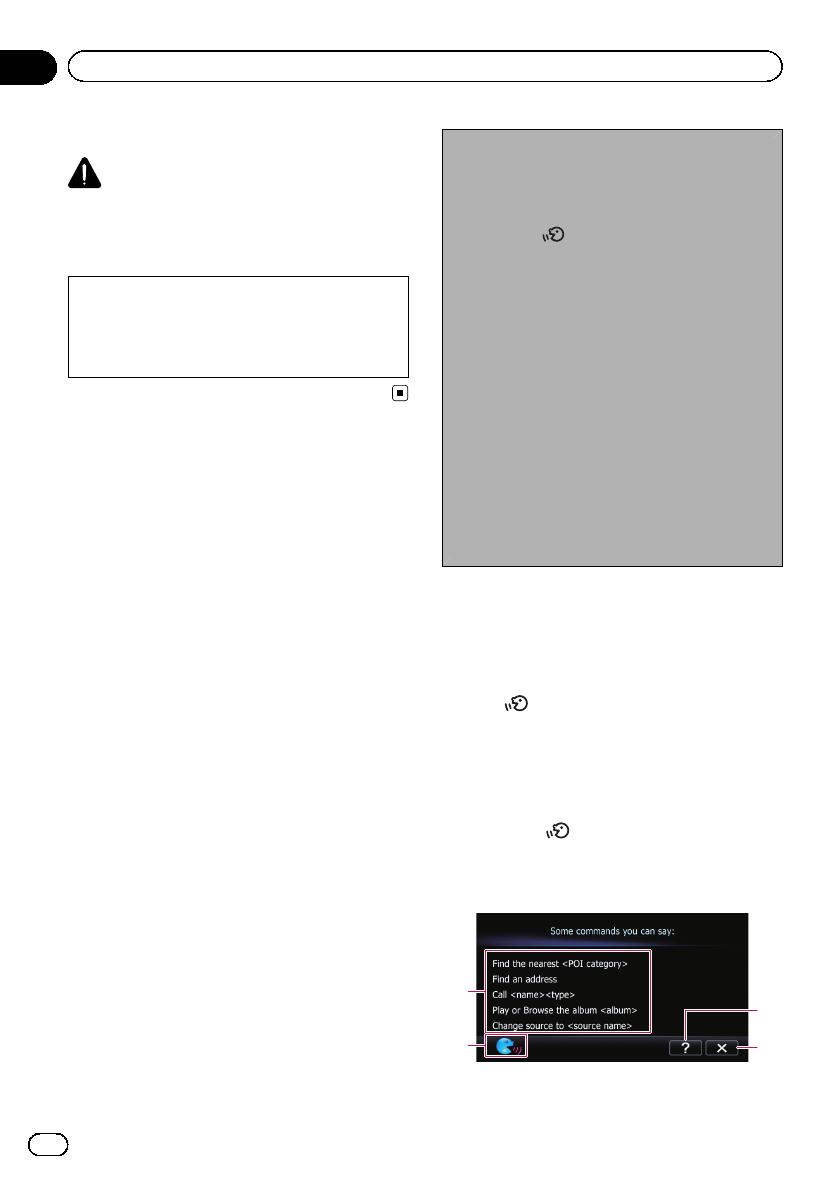
To Ensure Safe Driving
CAUTION
For your safety, avoid viewing the screen in the
voice operation as much as possible while
driving.
If you use voice operation, select [English]in
[Voice Language]of“Regional Settings”.If
you select other languages, voice operation
will not be available.
Basics of Voice Operation
Your Pioneer navigation system uses the latest
in voice recognition technology. You can use
voice commands to operate many of its func-
tions. This chapter describes where you can
use voice commands, and also what com-
mands the system accepts.
pThis function is not available while the cata-
loging of iPod is created.
Flow of voice operation
You can start voice operation any time even
when the map screen is displayed or AV is op-
erating. (Some operations are not available.)
The basic steps of voice operations are as
follows.
!Switch the screen to map screen or AV op-
eration screen.
j
!Press the button to activate voice oper-
ations.
j
!Speak a command into the microphone
after the beep.
When the command is recognized, the na-
vigation system displays next options on
the screen, and pronounces it in some
cases.
j
!Repeat previous step as necessary.
j
!The requested operation will be carried out.
pThe voice operation may not be operable for a
minute after the navigation system has booted
up.
pVoice operation will be activated 30 seconds
after the map screen is displayed.
If the button does not respond, display
the disclaimer screen and then touch [OK].
The map screen is displayed.
Starting voice operation
%Press the button when the map
screen or the AV operation screen is dis-
played.
The voice operation screen appears.
1
2
3
4
En
178
Chapter
32 Operating Your Navigation System with Voice

1Voice help menu:
Displays a list of commands for voice oper-
ation.
2Voice operation condition indicator:
When is indicated, the navigation sys-
tem can recognize your voice commands.
3:
You can listen to the brief operating in-
struction.
4:
cancels voice operation.
You can cancel the voice operation feature
at any time by saying “Cancel”. After you
cancel voice operations, the display returns
to the screen displayed before the voice op-
eration screen appeared.
How to use the voice operation
Searching for a location by address
In this example, you want to search for a loca-
tion by address and set it as your destination.
pWhen the list of candidates with number
appears, say the number that you want to
select.
When you select the entry next to “1”, say
“Number One”.
pIf there are multiple items that correspond
to the name you gave, the list screen ap-
pears. In this case, touch the item you want
to select from the list.
1 Press the MODE button to display the
map screen or the AV operation screen.
2 Press the button to activate voice
operations.
A list of commands for voice operation ap-
pears. After a message, the beep indicates
that the system is ready to accept your voice
command. Say a command after this beep.
3 Say “I need directions”.
A message prompting you to select a search
by address or by POI appears.
4 Say “Find an address”.
A message prompting the next operation is
given.
5 Say the state name that you want to
set to your destination.
6 Say the city name that you want to set
to your destination.
7 Say the street name that you want to
set to your destination.
8 Say the house number that you want
to set to your destination.
Your navigation system sets the route to your
destination, and the map of your surroundings
appears.
#If you say “Just go there”, the navigation sys-
tem sets the route to the representative location
of the city or the street.
Search for POI in vicinity
In this example, you want to search for a POI
and set it as your destination.
pWhen the list of candidates with number
appears, say the number that you want to
select.
When you select the entry next to “1”, say
“Number One”.
pIf there are multiple items that correspond
to the name you gave, the list screen ap-
pears. In this case, touch the item you want
to select from the list.
1 Press the MODE button to display the
map screen or the AV operation screen.
2 Press the button to activate voice
operations.
A list of commands for voice operation ap-
pears. After a message, the beep indicates
that the system is ready to accept your voice
command. Say a command after this beep.
3 Say “I need directions”.
A message prompting you to select a search
by address or by POI appears.
En 179
Chapter
32
Operating Your Navigation System with Voice
Operating Your Navigation System with Voice

4 Say “Point of interest”.
The list of POI categories appears.
5 Say the category that you want to set
to your destination.
The list of candidates with number appears.
6 Say the number that you want to
select.
Your navigation system sets the route to your
destination, and the map of your surroundings
appears.
Calling the entry on “Contacts”
A method for dialing the entry named “Nancy”
is described here along with an operational ex-
ample.
1 Press the button to activate voice
operations.
2 Say “Call Nancy”to make a call.
A message confirming whether to dial appear-
s.
3 Say “Yes”.
Dialing starts.
Operating iPod by voice
You can play music using voice operation from
the iPod connected to the navigation system.
pTo use the content/data on the iPod for
voice operation, transfer the data to this
system first.
=For details, refer to Acquiring/Cataloging
iPod music information on page 170.
Examples of voice operation of the iPod are
shown below. (A method for playing the album
title named “Pioneer”is described here, along
with an operational example.)
1 Press the button to activate voice
operations.
2 Say “Change Source”to display the AV
source selection screen.
3 Say “iPod”on the selection screen to
switch the AV source to iPod.
pTouching the item on the screen also en-
ables you to select the desired AV source.
4 Press the button to activate voice
operations.
5 Say “Play the album Pioneer”to play-
back the album name “Pioneer”.
If the command is recognized properly, play-
back starts from the first song of “Pioneer”.
En
180
Chapter
32 Operating Your Navigation System with Voice